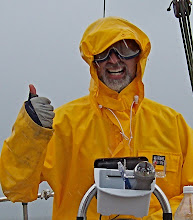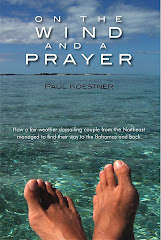This is a good idea because why again?
It’s the time of year when, comfortably cuddled in the bosom
of winter, a sailor up North can reflect on the fact that he’s in about as much
trouble out of the water as he was in.
We had an early reprieve from the travails of sailing this
season when our stern tube, it being part of a quixotically designed driveshaft arrangement,
finally unseated itself from the hull, and we began to take on water at a
fairly precipitous rate. The symptom was discovered on the Fourth of July, at
the end of a carefree visit to a nearby harbor hosting their annual fireworks
spectacle. Thankfully, none of the revelers onboard had become aware of the
fact that they’d come close to having to swim home.
We were removed from the ocean the next day, after I’d
pumped a hundred or so gallons out of the bilge for the second time in a matter
of hours. Game over. Or rather, let the games begin. I made the somewhat
energized call to our yard to please pull our boat ASAP, and then spent the
next couple weekends trying to figure out where the hell all the water was
coming from.
We pumped water all over the boat in an attempt to find the
leak. There are myriad possibilities for water ingress on a modestly sized
sailboat, and any boater will tell you that where the water ends up is frequently nowhere near where the water entered in the first place. Usually the most
suspicious looking areas have nothing to do with it, I can tell you that.
I finally pumped water under pressure around the prop shaft,
after removing the prop and jury-rigging some fire hose to a water hose. Bingo.
But before you go, “I knew it – the stuffing box!” know that you would be
wrong. I used a small digital camera on
a rod with a flashlight attached, and got video of a trickle I thought I’d
heard, buried below the underside of a packing gland in perfect working order,
thank you very much. See, I know all the damn terminology, so there.
The important take-away here is that, having finally diagnosed
the problem, I then proceeded to attempt the repair myself, with the obvious
result. I botched it, and in so doing I squandered time and money, and now
someone who does this for a living is going to have to work harder and charge
me more money then if I were to have walked away with my hands up, credit card clutched
in one of them.
Along with the serious structural problem, I also noticed
hull blistering for the first time, or rather a boating pal did, the bastard. This
problem is anathema to owners of old plastic boats, and was probably
exacerbated by our having left the boat in the water for two straight winters, for
no good reason. After having employed the dubious strategy of wet storage in
the Northeast, we can retire Deb’s fantasy for good. She’d convinced me that we’d
save a couple bucks and put ourselves in the enviable position of being able to
take to sea should we be visited by a stretch of unseasonably pleasant weather.
Just think, if it warms up some...
I don’t care if global warming brings our bay to a slow
simmer in the near future. The fact that we’d have to re and de-commission the
boat every time we feel like a joyride in January when temperatures soar into
the mid-forties would put a killjoy on my boat jones, you dig? Unless you’re
from South Florida, winter is for winter activities, fruitcake frost-biters be
damned.
With skewed knowledge as to what blister repair involves, and
in an attempt to incite general wharf-side derision, I went at the hull to expose
the extent of the decay. Armed with a borrowed grinder, and a purchased Tyvek
suit, respirator and goggles, I over-abraded about an eighth of the hull before
conceding ignominious defeat. Folks, this is a job left to lunatics, slaves,
and disreputable “handymen.”
So, facing the two-pronged assault of rapid and long-term
boat dissolution, I considered with some interest the approach of Hurricane
Sandy. With weather forecasting coming into its own in recent years, I was
looking at a fairly reliable insurer’s report declaring a total write-off.
Predictions of a seventeen-foot storm surge practically assured that our boatyard
would be turned into a giant billiard table, with everybody renaming their floating
investments “Eight-Ball.”
We did our best to prepare our lovely Laura Lynn for the coming apocalypse, because we’re responsible
citizens. But the dark lizard brain in me saw an escape route. You feel me? Hey, I paid my premium.
Yet it was not meant to be. A near miraculous wind shift at the crucial hour staved off the midnight surge, and virtually everyone in our harbor was spared. Wahoo.
Yet it was not meant to be. A near miraculous wind shift at the crucial hour staved off the midnight surge, and virtually everyone in our harbor was spared. Wahoo.
Visiting the boat depresses me now, so I rarely do it. As a
result, the seacocks are corroded shut, or open if that’s the way they’re supposed
to be. I can’t remember. Vermin can’t get in; water can’t get out. Whatever. In
any event, you should tend to your boat in the winter.
Deb and I passed the yard a couple days ago, on a walk,
because the weather was tolerable. Walks are not to be confused with sails.
Anyway, we noticed one mast conspicuously heeled to port. That always makes a
sailor take notice, so we tacked. Sure enough, a nice mid-sized boat had fallen
on its hip, a victim of high winds, most likely. It shouldn’t have happened, but
it did. The owner is likely going to pitch a fit when he finds out. Us, we’d
had our mast pulled, so as I approached, I did so without any sense of hopeful
expectation.






